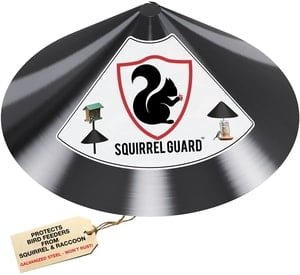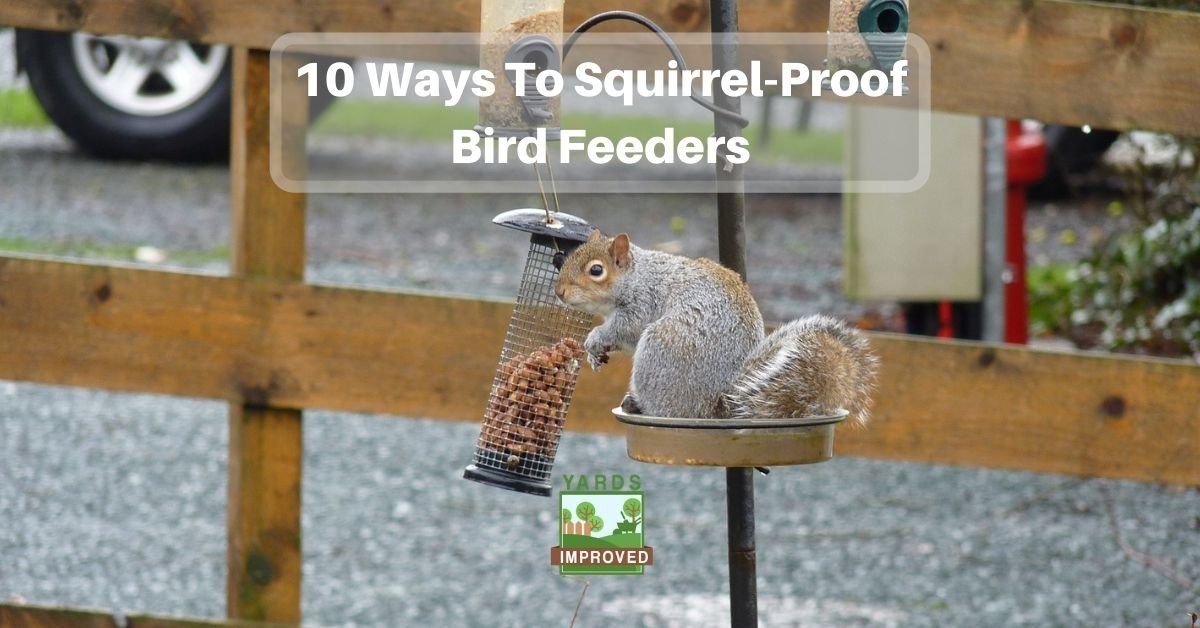Squirrels can be incredibly cute and entertaining, sure. But at the same time, they can be a nuisance. And they LOVE raiding bird feeders! You may not mind having the little bushy-tailed rodents around. But you also want birds to be able to enjoy the seed you put out for them.
Birdseed is for the birds, and it can be tough to keep it that way. Squirrels are clever, nimble, and fast. But there are some steps you can take to help keep them from raiding the cupboard! At the same time, your feathered friends will still be able to enjoy the feast you’ve set out for them.
You can try one or more of these tricks. Not all might be feasible in your yard, but surely you’ll find something that works! There are a lot of types of bird feeder, too, and not every tip will work with all of them.
Get A Squirrel-Proof Feeder
The quickest and easiest way to defeat the squirrels is to buy a feeder that’s designed to keep them out. They incorporate some of the tips we’ll talk about below, like roofs or bases that prevent the squirrels from climbing onto them.
Most of these feeders will only have small perches for birds so that the squirrels don’t have a place to stand. However, that can also mean that these are only suitable for smaller birds.
Of course, you still have to consider other factors like the positioning of your feeder. Otherwise, a squirrel could still stretch out to it or make a daring leap, hoping to grab a perch.
Keep It Out Of Reach
If a squirrel can get to your bird feeder, it’s going to try. And they’re great and bold leapers!
To keep a bird feeder from being a target, you have to be sure it’s far enough away from jumping-off points. That includes tree branches, the deck, and even the roof!
Squirrels can jump up to five feet high. They can also “long jump” about seven feet from one point to another. So you want your feeder at least that far away.
They’re also not afraid to jump downwards. They can often drop as far as nine feet without fear. So you don’t want to have your feeder too close to an overhang or tree.
Remember – over 5 feet high, 7 feet across, and 9 feet from above!
Make Them Walk A Tightrope
Hanging your bird feeder from a vertical wire can be another way to keep the squirrels at bay. They’re great climbers, of course. But they’ll have difficulty holding onto a thinner line strung between two points. A clothesline might still be easy for them, but wire rope or another stiff, narrow wire often does the trick.
Keep a little slack in the line so that it sways a bit if a squirrel does get onto it can help scare them away, too.
Keep It Spinning
If your bird feeder hangs from above, it can help to tie it so it can spin if a squirrel (or another animal) lands on it. The feeder could be made that way or you could be sure to tie it so it moves freely.
Birds are, of course, much lighter than squirrels. They won’t get the feeder turning. But a squirrel landing on it can start it revolving. That leads to a dizzy squirrel who isn’t likely to want to relive the experience!
Cover It With A Screen
Obstacles are a common theme of our next few tips. One idea is to use a screen that will allow smaller birds to get seed through it. But squirrels won’t be able to get their paws through!
Of course, the mesh can’t be too small. And this isn’t suitable if you want to feed larger birds. But it can be enough to frustrate your opponents and keep them from coming back.
A Baffle Above, A Baffle Below
“Baffles” are simply basic covers that can keep squirrels from coming up a pole or down a wire. These are a major feature of many squirrel-proof bird feeders.
They’re usually a sloped surface that is bigger across than the feeder itself. They wrap around the pole or wire so that the squirrel can’t get past it.
Bird Feeder Baffle

If you’re placing a baffle below the feeder on a pole, be sure to place it high enough that the squirrel can’t jump above it from the ground.
Add A Slinky To The Pole
An old-fashioned kids’ toy can be another great way to prevent squirrels from getting to the birdseed.
Put the pole for your bird feeder through a Slinky. Keep the bottom of the slinky a couple of feet above the ground. It can go up as high as the bottom of the feeder, but it doesn’t have to. You can tie it in place with wire.
The squirrels just won’t be able to get a grip on the moving surface!
Grease The Pole
Another option if your feeder is mounted on a pole is to grease the pole. Grease or cooking oil won’t harm the environment but will be slippery enough that the squirrel can’t get a grip to climb up.
You’ll soon have a very frustrated little guy who just can’t reach his intended destination.
Provide An Alternative
Everyone loves a meal, but no one wants to put more work into it than necessary. And if squirrels have another source where they can get food, they’re more likely to leave your bird feeder alone.
You can get a squirrel feeder and fill it with goodies they’ll love. Attach it to a tree or other convenient place.
Use Feed That Squirrels Don’t Like
Of course, if you put out food for the birds that squirrels don’t like, then you won’t have a problem. The hard part of this is that squirrels love most of the same seeds.
However, you can still attract birds like goldfinches. Nyjer seeds are their food of choice but of no interest to squirrels.
Conclusion
Keeping squirrels from stealing all your birdseed can be a major challenge. After all, that seed can be pretty delicious from their perspective. Fortunately, there are many tricks you can use to make sure your birdseed feeds the birds. With the tips here, you and your birds will both be much happier!










